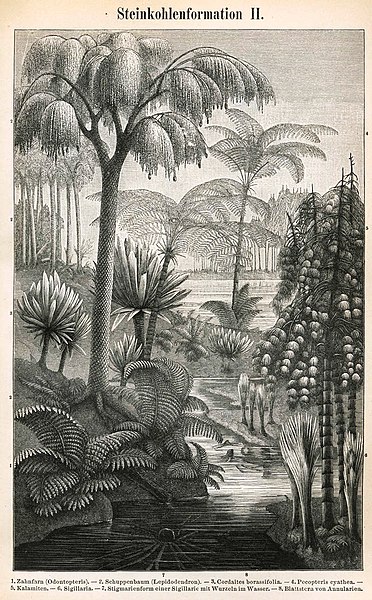The Carboniferous is a geologic period and system of the Paleozoic that spans 60 million years from the end of the Devonian Period 358.9 Ma to the beginning of the Permian Period, 298.9 Ma. In North America, the Carboniferous is often treated as two separate geological periods, the earlier Mississippian and the later Pennsylvanian.
Cliff section through the Serpukhovian Red Wharf Limestone Formation, Wales. A marine limestone at the base of the cliff is overlain by an orange-coloured fluvial sandstone. Subaerial exposure of the limestone during a period of falling sea level resulted in the formation of a karstic surface, which has then been infilled by the river sands. A thin, estuarine silty mudstone overlays the sandstone, which in turn is overlain by a second marine limestone.
Hyden Formation over Pikeville Formation in the Pennsylvanian of Kentucky, US. The exposure has Pennsylvanian-aged cyclothemic sedimentary rocks of the Breathitt Group. The upper part of the roadcut is Hyden Formation, consisting of mixed siliciclastics and coal. The lower part is Pikeville Formation, also having mixed siliciclastics and coal.
A reconstruction of life on a forest floor during the Pennsylvanian Period. The reptile is Edaphosaurus, a pelycosaur. Plants are the seed ferns Neuropteris and Pectopteris, the club mosses Lepidodendron and Sigillaria, other plants include Cordaites, Calamites, climbing ferns, pond algae, and Sphenophyllum.
Etching depicting some of the most significant plants of the Carboniferous
The Devonian is a geologic period and system of the Paleozoic era during the Phanerozoic eon, spanning 60.3 million years from the end of the preceding Silurian period at 419.2 million years ago (Ma), to the beginning of the succeeding Carboniferous period at 358.9 Ma. It is named after Devon, South West England, where rocks from this period were first studied.
The rocks of Lummaton Quarry in Torquay in Devon played an early role in defining the Devonian Period
Diorama of a Devonian seafloor
Prototaxites milwaukeensis, a large fungus, initially thought to be a marine alga, from the Middle Devonian of Wisconsin
The Devonian Period marks the beginning of extensive land colonization by plants. With large land-dwelling herbivores not yet present, large forests grew and shaped the landscape.








